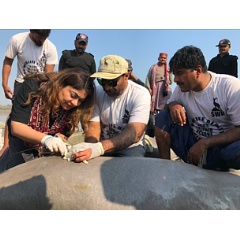First ever satellite tagging of river dolphins in Asia
Three endangered Indus river dolphins safely tagged in Pakistan
In a major boost to conservation of the endangered Indus river dolphin, WWF experts in collaboration with the Sindh Wildlife Department safely tagged three dolphins in Pakistan with satellite transmitters - the first time that such technology has been used on any of the river dolphin species in Asia.
The three river dolphins - two adult females and a young male - were tagged after being rescued from irrigation canals in Sukkur, before being successfully released back into the Indus River. The dolphins were tagged with the utmost care, with a veterinarian administering local anesthesia before applying the tags.
Preliminary satellite data appears to show that the technology is working and scientists are expecting unprecedented information about the dolphins in the coming weeks.
“This pioneering project is a major milestone for the long-term conservation of the Indus river dolphin as we are expecting it to reveal a wealth of information about the movement, behaviour and habitats of this iconic species,” said Dr Uzma Khan, Asia Coordinator for WWF’s River Dolphin River Initiative, who led the tagging team.
“I am so honoured to have been part of the team that satellite tagged the first river dolphins in Pakistan - and indeed in Asia. It could help to transform our knowledge of these incredible animals" added Khan.
The Indus river dolphin is an endangered species, but thanks to the collective efforts of the Sindh Wildlife Department, WWF and communities their population has increased from 1,200 to 2,000 over the past two decades.
This success has been achieved despite knowing little about their movements and behaviour in the Indus river, which is naturally so full of sediment that it is very difficult to track or study the dolphins. Indeed, the river is so murky that the Indus river dolphin is functionally blind, evolving to use echolocation to catch prey rather than its eyes.
For the first time, the satellite tags will allow scientists to build up an accurate picture of the activities of these dolphins, which only surface for a very short time to breathe. The data will hopefully help to answer many vital questions, including how they use different habitats, how effectively they travel through the large irrigation barrages on the river, how far they move in a day, and if there is any difference between the movement patterns of males and females.
“Tagging dolphins is new to Pakistan and we are pleased to contribute to this pioneering study in Asia,” said Javed Mehar, Conservator Sindh Wildlife Department. “If this experiment is successful then the government of Sindh will carry this initiative forward and scale it up.”
The Sindh Wildlife Department leads efforts every year to rescue Indus river dolphins that become stranded in irrigation canals. Working with WWF and communities, the department has successfully rescued about 200 dolphins since 1992.
Satellite tagging of river dolhins was pioneered in South America, where around 50 Amazon river dolphins have been successfully tagged, providing critical information for conservation. A Yangtze finless porpoise - the only species of freshwater porpoise - was also tagged once in China.
“Collective efforts are key to saving river dolphin species across Asia but until now we have been working in the dark, blind to the details of how these animals behave: satellite tagging promises to shine a much-needed light on their habits and movements,” said Daphne Willems, Lead, WWF River Dolphin Rivers initiative.
“I cannot wait to start seeing the data and finding out where exactly these dolphins go when they are out-of-sight below the surface of the Indus" added Willems.
( Press Release Image: https://photos.webwire.com/prmedia/6/284308/284308-1.png )
WebWireID284308
This news content was configured by WebWire editorial staff. Linking is permitted.
News Release Distribution and Press Release Distribution Services Provided by WebWire.
